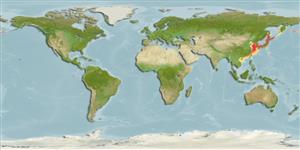>
Perciformes/Zoarcoidei (Eelpouts and pricklebacks) >
Stichaeidae (Pricklebacks) > Stichaeinae
Etymology: Ernogrammus: Greek, ernos, -eos, -ous = bud, shoot, descendenat + Greek, gramma = letter, mark, signal (Ref. 45335).
More on author: Schlegel.
Environment: milieu / climate zone / depth range / distribution range
Ecologie
marien demersaal; diepte 0 - 142 m (Ref. 50610). Temperate
Northwest Pacific: Japan to the Gulf of Po-Hai (Gulf of Chihli), the Sea of Japan, and the southern Kuril Islands.
Grootte / Gewicht / Leeftijd
Maturity: Lm ? range ? - ? cm
Max length : 15.0 cm SL mannelijk / geslacht onbekend; (Ref. 559)
Inhabit coastal, near rocky reefs among algae and rocks; also brackish waters (Ref. 51666). This nocturnal fish hide between stones during the day and move to sandy areas in the evening for foraging. Feeds mainly on polychaetes and mysids, decapod crustaceans, fishes, algae and sipunculans. A solitary species with low level of contacts and aggression. Potential predators include Squalus acanthias, Sebastes taczanowskii, and S. trivittatus, sea scorpions Myoxocephalus, and cormorants (Ref. 86742). Oviparous, eggs are guarded by the male (Ref. 58332).
Levenscyclus en paargedrag
Maturiteit | Voortplanting | Paaien | Eieren | Fecunditeit | Larven
Masuda, H., K. Amaoka, C. Araga, T. Uyeno and T. Yoshino, 1984. The fishes of the Japanese Archipelago. Vol. 1. Tokai University Press, Tokyo, Japan. 437 p. (text). (Ref. 559)
Status op de Rode Lijst van het IUCN (Ref. 130435)
Gevaar voor de mens
Harmless
Gebruik door de mens
Meer informatie
Lokale namenSynoniemenMetabolismePredatorenEcotoxicologieVoortplantingMaturiteitPaaienPaaiaggregatiesFecunditeitEierenOntwikkeling van de eieren
ReferentiesAquacultuurAquacultuurprofielKweeklijnenGeneticaElectrophoresesErfelijkheidZiektesVerwerkingNutrientsMassaconversie
Tools
Speciale rapporten
Download XML
Internetbronnen
Estimates based on models
Preferred temperature (Ref.
123201): 3.8 - 20.6, mean 15.4 °C (based on 196 cells).
Fylogenetische diversiteitsindex (Ref.
82804): PD
50 = 0.6250 [Uniqueness, from 0.5 = low to 2.0 = high].
Bayesian length-weight: a=0.00447 (0.00228 - 0.00875), b=3.12 (2.94 - 3.30), in cm total length, based on LWR estimates for this species & (Sub)family-body (Ref.
93245).
Trofisch niveau (Ref.
69278): 3.3 ±0.5 se; based on size and trophs of closest relatives
Weerstandsvermogen (Ref.
120179): Gemiddeld, minimale populatieverdubbelingstijd 1,4-4,4 jaar (Preliminary K or Fecundity.).
Fishing Vulnerability (Ref.
59153): Low vulnerability (10 of 100).
